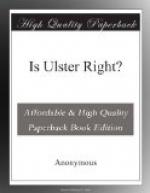During the early part of the century, Ireland had another period of prosperity. Travellers through Ireland at the present day cannot fail to notice how many of the country seats (now, in consequence of later legislation, mostly deserted and already beginning to fall into ruin) were built at that time. No doubt much of the prosperity was caused by the rebound which often takes place after a period of anarchy and desolation; and it would not be fair to attribute it wholly to the effect of the Union; but at least it proves that the melancholy prognostications of the opponents of the measure were happily unfulfilled. The total value of the produce and manufactures exported from Ireland between 1790 and 1801 amounted to L51,322,620; between 1802 and 1813 it amounted to L63,483,718. In 1800 the population of Ireland was under 5,000,000; in 1841 it was over 8,000,000. The tonnage in Irish ports in 1792 was 69,000; by 1797 it had fallen to 53,000; before 1852 it had risen to 5,000,000. The export of linen in 1796 was 53,000,000 yards; in 1799 it had fallen to 38,000,000; in 1853 it had risen to 106,000,000; and every other department of industry and commerce showed figures almost as satisfactory.
There were, however, three important measures which the leading advocates of the Union had desired to see carried as soon as possible after the great change had been effected, but which—as many writers of various schools of thought to this day consider unfortunately—were postponed. The first was a provision by the State for the payment of the Roman Catholic clergy. The bishops had fully expected that this would be carried. Some modern Nationalists, wishing to win the favour of the English Nonconformists, have represented that the Roman Catholic Church refused to accept the money; but that is not the case. Whether the policy of “levelling up” would have been a wise one or not, it is useless now to conjecture; for once the policy of “levelling down” had been decided upon, and the Irish Church had been disestablished and disendowed, it became impracticable. The second measure was Roman Catholic emancipation. This had been intended by Pitt and other statesmen who helped to bring about the Union; but unforeseen difficulties arose; and unfortunately nothing was done until the agitation led by O’Connell brought matters to a crisis; and the emancipation which might have been carried gracefully years before, and in that case would have strengthened the Union, was grudgingly yielded in 1829.
The third measure was a readjustment of tithes. All will now admit, and very many politicians and thinkers at the time fully realized, that the old law as to tithes was a cruel injustice; but no change was made until the opposition to the payment of tithes amounted to something like civil war, involving a series of murders and outrages. Then the fatal precedent was set of a successful and violent revolt against contracts and debts. In 1838 an Act was




